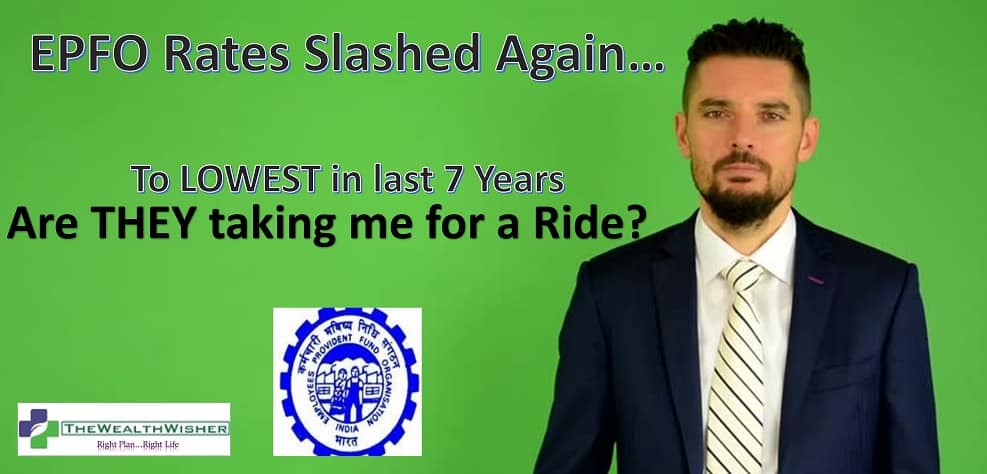The rates are falling everywhere (except the US) and so EPFO also finalized the interest rate to 8.65% pa for 2016-17. This is a fall of 15 bps (1%=100 basis points) as earlier it was an 8.8%. The EPFO (Employees Provident Funds Organisation), has roughly 17 crore accounts and every year they take a view on the prevailing rates and announce for any new cut or increase.
To give you a background, EPFO decisions are made by Central board of Trustees and stakeholders like Ministry of Labour and various Worker Unions are given representation before such decisions are made. Also, the rates are compared to small savings schemes like PPF etc..
The rates are also calculated keeping in view the liability (interest payments) vis-à-vis investment growth. The EPFO money is invested in markets as per guidelines set by Labour Ministry and each year the figure of growth minus the expenditure is taken for redistribution.
In the case of a surplus, the amount is reinvested and in the case of a deficit, the government bears the payment.
Why am I telling you this, because just by slashing the rate by 15 bps the Government saved a whopping Rs 383 Crores!!!
Yes, as if they would have paid at 8.8% the deficit was Rs 383 Cr, but with this rate cut, they have a surplus of Rs 69.5Cr. That is what I call… Business.
I also liked one more thing: They have recommended to slash administrative cost for 85 bps to 65 bps and also recommended to form a committee to study trends on last 10 year in the employment market and further formulate ways to reduce admin cost.
That is why I call it a good business: Increase earnings, decrease overheads. So I can say – our money is in better hands now.
(click image to enlarge)
But the rates are lowest in last 7 years. Are you happy?
What did the Unions say? They have a job to represent workmen. Well, the Bhartiya Mazdoor Sangh (BMS) said they are happy as it is still better than small savings rate and tax-free provision. The INTUC said they are unhappy as EPFO has made gains in equity investments and still not giving to subscribers.
Well, these are political views, as BMS is backed by BJP and INTUC is a Congress affiliate.
What do we think?
Even at 8.65%, the EPF will have more returns than its single counterpart which is Debt portion of NPS. Even if both of them make similar returns in long term, NPS still has to shed few bottlenecks related to taxation on the annuity. EPF is tax-free (after 5 years of continuous subscription) and will be a key investment strategy for financial & retirement planning.
So post-tax return are still better than, PPF, KVP, Sukanya Samriddhi Scheme, Bank Deposits and the LIC endowment/money back plans.
But… the lower rates will shrink your retirement corpus and in a span of say 25-40 years, the difference will be not small to forget.
The good thing is the rate directly influences 4 Cr subscribers (votes) and the government will continue to give priority to this rate. It will be marginally over the rest of interest rates.
So, in case you are an EPF subscriber, do continue to invest and have faith in your asset allocation. Keep rebalancing your portfolio as goals are more important than a small shuffle in an asset category.
Share your views on this rate cut and how do you feel now?
Other Previous Articles On EPF:
Rules to withdraw your EPF- All Scenarios
Step-By-Step Process to get Online EPF Passbook
How to check your EPF Balance Online
Keep sharing and forwarding this article and let all benefit from the knowledge you circulate.












People can contribute towards VPF to make up the loss in retirement corpus growth
Thanx Dilshad for your comment. Yes, Voluntary contribution can help. But first of all, it will decrease the cash in hand which will impact monthly budget or committed savings. Secondly, not many company HR encourage employee for VPF deduction as it is a hassle for them.
Keep visiting us and keep sharing your thoughts…
New rate is going to applicable from 1st April 2016 or 1st April 2017
Yes Sagar, the rates will be applied on the current FY ie 1 April 2016 to 31 March 2017. Also, the cut has been recommended by the trustees to Government. So next step would be government approving it and notifying it in the official gazette.